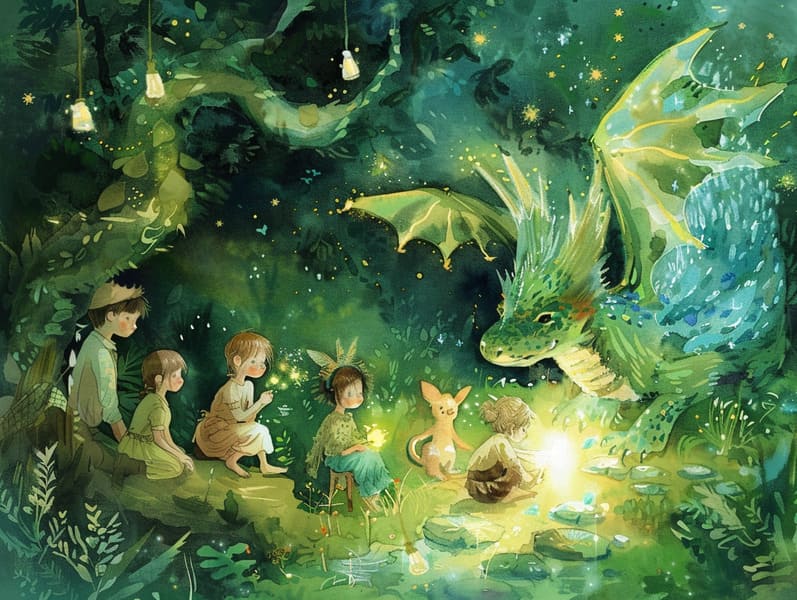Tracing the Heritage of Old Fairy Tales and Their Consistent Spell.
Tracing the Heritage of Old Fairy Tales and Their Consistent Spell.
Blog Article

Short fairy tales have long histories. These narratives have been recounted from one generation to the next ages before they were ever recorded. They came from a variety of cultures, including European traditions. They were initially conveyed among grown-ups, often carrying themes and messages aligned with the societal norms and beliefs of the time.
Jacob and Wilhelm Grimm, Jacob and Wilhelm (the Grimm brothers), were among the first to compile and publish many of these beloved stories. Their volume, "Grimm's Story Collection," included narratives like "Cinderella," "The Story of Hansel and Gretel," and "The True Story of Snow White," which have since become pillars in the world of beloved fairy tales. Similarly, H. C. Andersen's delightful stories, such as "The Mermaid," and "The Story of the Ugly Duckling," have captured hearts worldwide, securing their place in the pantheon of famous fairy tales.
Though they are centuries old, fairy tales remain as pertinent as ever, especially as bedtime stories for kids. These delightful tales are now available in multiple formats, including beautifully illustrated books, fantastical animations, and internet fairy tales.
Their unwavering allure can be ascribed to several captivating elements:
Important Morals: Traditional fairy tales often illustrate important moral lessons. Fairy tales like "The Boy Who Cried Wolf" teach the importance of truth, while "The Tortoise and the Hare" demonstrate the merits of perseverance and modesty. These narratives offer young readers clear distinctions between truth and falsehood, molding their moral compass in a gentle yet lasting way.
Warmth and Understanding: Old fairy tales frequently portray heroes facing difficulties and adversities, inspiring kids to feel with their struggles and rally behind their triumphs. For instance, "Beauty and Her Beast" conveys the importance of looking past the exterior to comprehend the real person of a soul, developing tenderness and comprehension.
Cultural Recognition: Many old fairy tales are imbued with the cultural contexts from which they bloomed. Learning from these tales can provide fascinating glimpses into different societies, advancing a sense of world respect and comprehension.
Inventiveness and Imagination: The fantastical elements in fairy tales—magical spells—inspire children’s dreams. These tales take readers to supernatural realms, activating inventive dreams and a sense of magic that endures a lifetime.
Classic fairy tales are not only enchanting but also educational. They act as fascinating tools in cultivating various mental and emotional abilities in kids. When timeless fairy tales are recited, they boost communication skills by presenting new language items and elaborate sentence structures. This practice also promotes listening abilities and focus, as young readers concentrate deeply, anxious to see what happens next.
Furthermore, reflecting on the themes and characters of fairy tales can promote thinking skills and problem-solving abilities. Children learn to see patterns, foresee events, and figure out cause and effect. These contemplations also contribute to read more children reveal their thoughts and feelings, contributing to their emotional intelligence.
In today’s information age, the existence of online storybooks has made these narratives more attainable than ever. Internet sites and programs extend vast collections of ancient fairy tales that can be seen or played anytime, anywhere. Fairy tales recited are particularly liked, extending an interactive way for the young to appreciate these delightful tales. Audio stories and read-to-me stories guide characters and settings to life, often accompanied by mesmerizing soundtracks and melodies that boost the tale-telling adventure.
The everlasting appeal of traditional fairy tales lies in their ability to adjust to today's society while keeping hold of their central messages. Contemporary revisions of these stories often highlight more different protagonists and modern settings, making them meaningful to today’s audience. However, the essential messages of gallantry, benevolence, and righteousness remain unchanged, continuing to connect with young readers of all ages.
Classic fairy tales also offer a sense of peace and homeliness. They extend a structured narrative with a definite beginning, middle, and end, often coming to a close with the wrap-up of conflicts and the triumph of truth over falsehood. This regularity can be solacing for children, showcasing a sense of consistency in an constantly changing world.
Traditional fairy tales continue to bewitch and edify new generations, maintaining their mystique and pertinence in modern society. As children's bedtime stories, they render a perfect blend of captivation and insight, sustaining moral values, empathy, and creativity. The availability of online storybooks and the in demand status of fairy tales narrated affirm that these timeless stories remain within reach to new generations.
By perpetuating and imparting these stories, we continue to extol the rich tapestry of myths and cultural heritage. Whether you are accessing a beautifully illustrated book, viewing a digital library, or listening on an audiobook, the loveliness of classic fairy tales is always within reach. These stories convey of the unfading force of stories and its ability to bond us across centuries and lands.
No matter if you are delving into a gorgeously illustrated book, seeing a digital library, or listening via an read-aloud book, the allure of traditional fairy tales is always within reach.
These stories emphasize of the enduring presence of tales and its ability to unify us across centuries and lands, casting a charm that charms and informs alike.